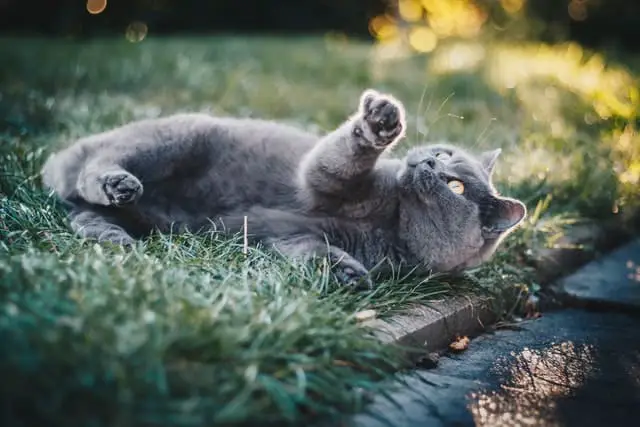
A cat’s paws are a very sensitive part of his body: here’s why and how to take care of them without damaging them.
Our beloved feline friend has particularly delicate areas of the body, to which he himself is very sensitive. Among these there are certainly the legs: they must be healthy and always well cared for, to avoid annoying infections and redness from showing up on them. They need them to move and climb, so it is absolutely important that they are always in perfect shape. Here’s how to cure them.
The paws of the cat: anatomy
How are cat paws made? There are two front and two hind legs. Depending on the breed of the cat their size changes, however the anatomy is always the same. The front and back legs have 5 toes each, equipped with retractable claws, composed of keratin: the only difference is that the hind legs are slightly longer than the others.
When the cat walks, it rests its weight on its front paws. They are equipped with a carpal pad, a metacarpal pad, and digital pads (on which the cat rests). The hind legs instead have a metacarpal pad and digital pads.
Let’s move on to the cat’s fingers: each finger consists of phalanx, muscle and elastic ligament (which allows the claws to be retractable). If the claws are out it means that the ligament is tight, if they are hidden it is relaxed. Cat’s claws are usually long and sharp as they are used as a hunting weapon.
The pads are made of a solid fabric covered with wrinkled leather. Their function is to cushion the cat’s weight, protect the paw bones, and act as a flawless braking and landing system. They also allow the cat to move in a soundproof way, especially when it goes hunting. Among the pads are the sweat glands, which secrete a fragrant oil, precisely made of pheromones that act as an attraction for other cats. This is why when the cat rubs its paw on someone or something it does it to mark the territory, releasing its smell. Sweating from the pads, therefore, the cat maintains its stable temperature. Their color is the same as that of the coat.
The paws of the cat: why they are so important
The most obvious answer would be that cats are digitigrade animals and walk on the tip of the toes, or rather of the paws, unlike the man who is plantigrade, that is, he walks by placing the sole of the foot on the ground. In addition to being one of the most sensitive parts of his body, the paws are also the means through which contact can be established between the animal and the owner: this is why it is important to gain the cat’s full trust before touching them!
At the beginning it will not be easy for the cat to get used to this constant massage, so it is important to indulge his wishes: it must be a moment of relaxation, not torture! The pads must always be hydrated, as they are very sensitive to heat and cold. however, external agents can dry out the skin or crack it. For this reason, continuous hydration, both in summer and in winter, is necessary to prevent the skin from cracking. For their hydration it will be enough to use an emollient, such as petroleum jelly or olive oil.
Cat’s paws: how to take care of them
How can we take care of the cat’s paws while avoiding the danger of infections and chapping? Here are all the steps so that your cat always has healthy paws that are functional for all his activities.
- Massage: you have to handle them regularly, to relax him and perhaps taking advantage of the moment to reactivate his circulation. The massage must be gentle and maybe it is better to place the cat in your arms, so that he can feel safe in our arms. If the cat stays calm and gets a massage, it is good to reward him with some snacks, perhaps the one he likes so much. But be careful: let’s reserve it only at the time of the massage!
- Caress the back: taking it in your hands, hold it for about 3 seconds without applying any pressure. If the cat clearly demonstrates that it does not want to, we do not insist on contact, but we comply with his will. If he is not annoyed, use your fingers to stretch the claws outwards (to better show the nails to be cut).
- Trim your nails: If we’ve worked it out right before, the pedicure shouldn’t be a big deal. It should be done at least within two weeks of the last one. If the cat is intolerant, or even violent, it is good to use a restraint bag, so that he cannot scratch us. If your cat uses the scratcher frequently, the time between cuts can be even longer.
- Cleaning the paws: it is a necessary operation for the cat that comes out of the house, which has a garden available, but also for the one who lives in the house. Since they have a habit of licking their paws, it is important that they are always clean to prevent the cat’s tongue from catching debris, residues or, even worse, poisonous or toxic substances. To clean them you need to use a damp but warm cloth. Of course, let’s not forget to wash the floors well!
- Check the paws: it is also important to examine the space between the toes and the pads, so that cleaning is more thorough. In this way we can exclude the presence of infections, cuts, scratches, swollen areas or splinters. It is easy for the cat to get injured walking around the house or going outside.
- Trim the hair: the hair that grows between the fingers can be a real obstacle to its normal gait. Or in the winter months the snow could get trapped in the fur and cool the paw. To shorten it, it is better to use a pair of small scissors with a rounded tip, to prevent it from being injured with some sudden movements.
How to heal cat paw wounds

In case of serious injuries the fundamental thing to do is to contact the veterinarian or run to the nearest veterinary emergency room. If it is a matter of minor but annoying injuries or anomalies, then we take action and take action immediately. You will also need it easily: antiseptic substance, such as Betadine, gauze, clean cloths, tweezers and neutral soap.
To disinfect the paw, it is necessary to gently rub the paw with a cloth dipped in warm soapy water in order to eliminate debris. On the gauze pour the disinfectant solution and place it on the wound. If the cat bothers it, it is best not to force things and wait for it to calm down to continue.
If there are foreign bodies use tweezers, but always after disinfecting the paw and then clean it with soap and water. To grab the splinter with tweezers it is good to have a steady wrist to prevent the cat from moving continuously. If the splinter does not come off then it is necessary to take him to the vet.
Small precautions for the cat’s paws
In summer we make sure that the cat does not walk on a concrete floor which, in addition to being rough and therefore scratching it, would become very hot and could burn it. If it is a cat that usually lives outdoors, in the winter season we make an exception and keep it indoors.
We are always attentive to the state of health of the legs, precisely because small lesions or anomalies could hide more serious problems: insufficient intake of proteins, deficiency of fatty acids or some diseases such as diabetes.
If we are not sure we can cut our cat’s nails, let’s not use him as a guinea pig! We ask for help from a veterinarian or a toilet: perhaps by looking at expert hands, we will be able to learn how to do it on our own at a later time. Be careful not to cut them too short: you could reach the sensitive part of the claws and make it bleed.






